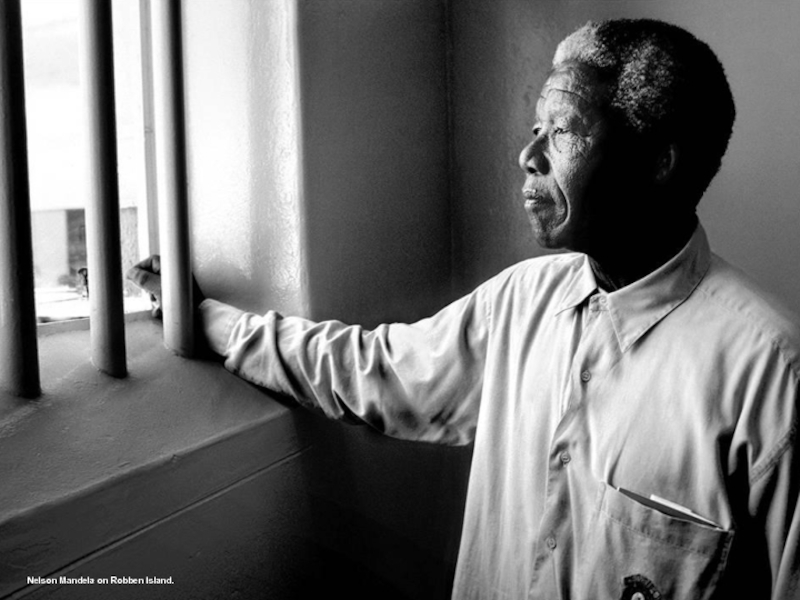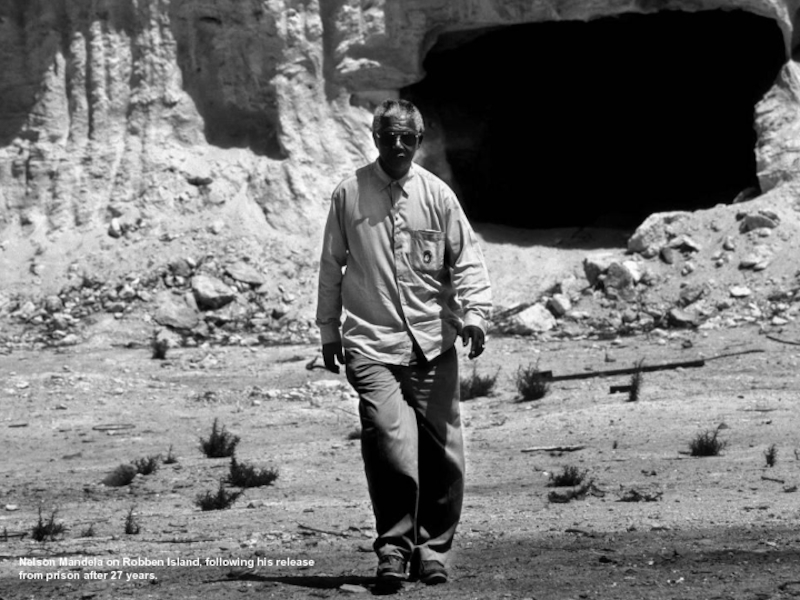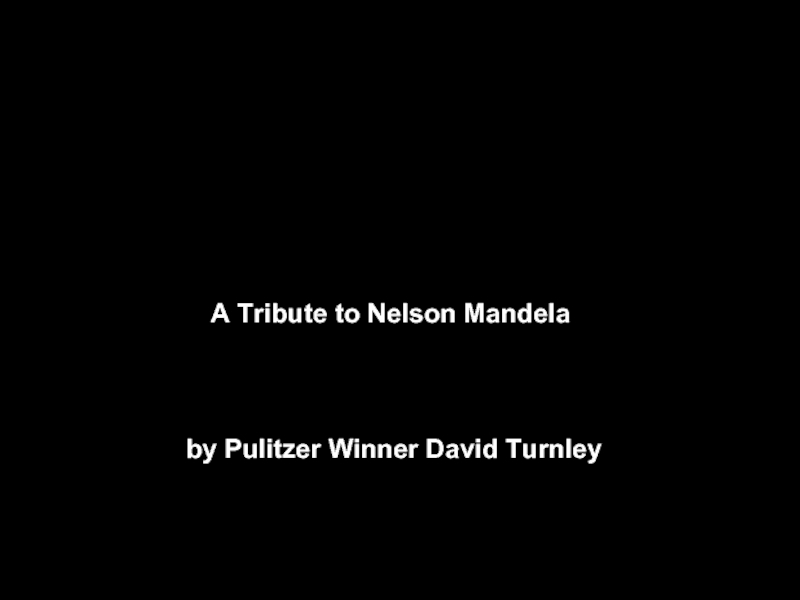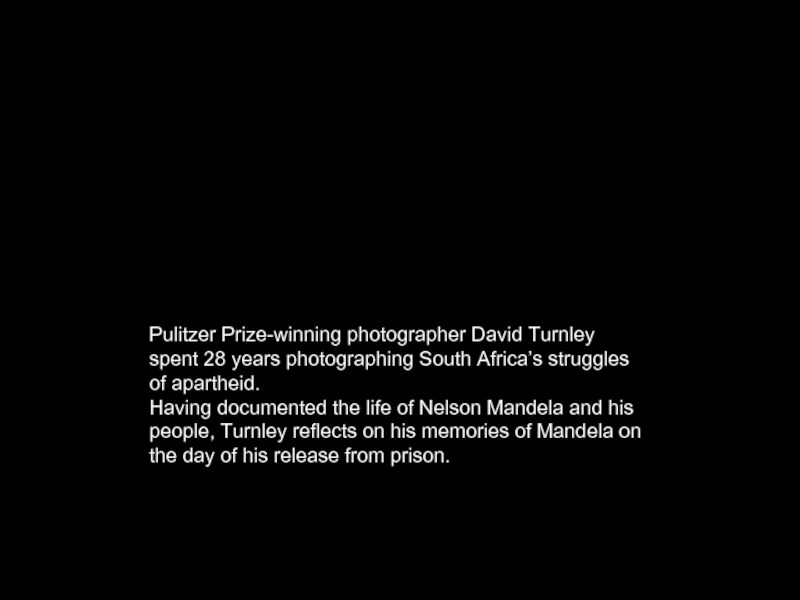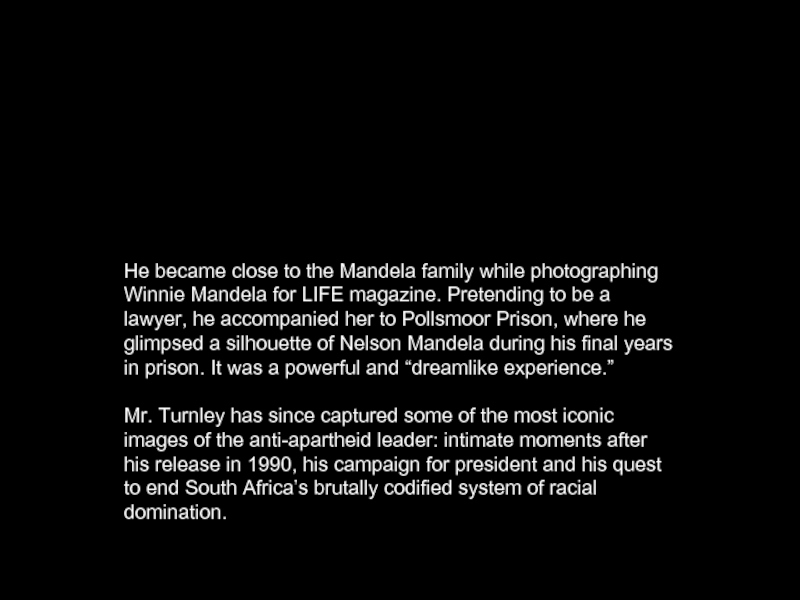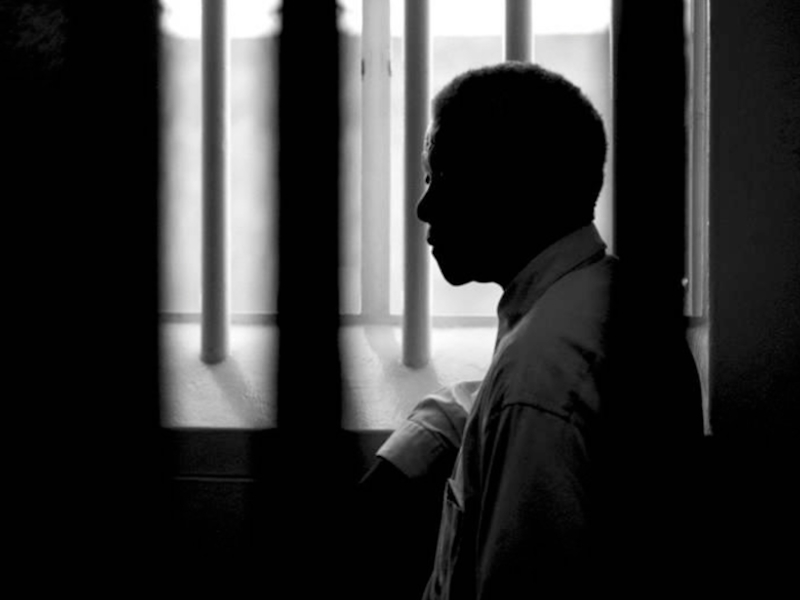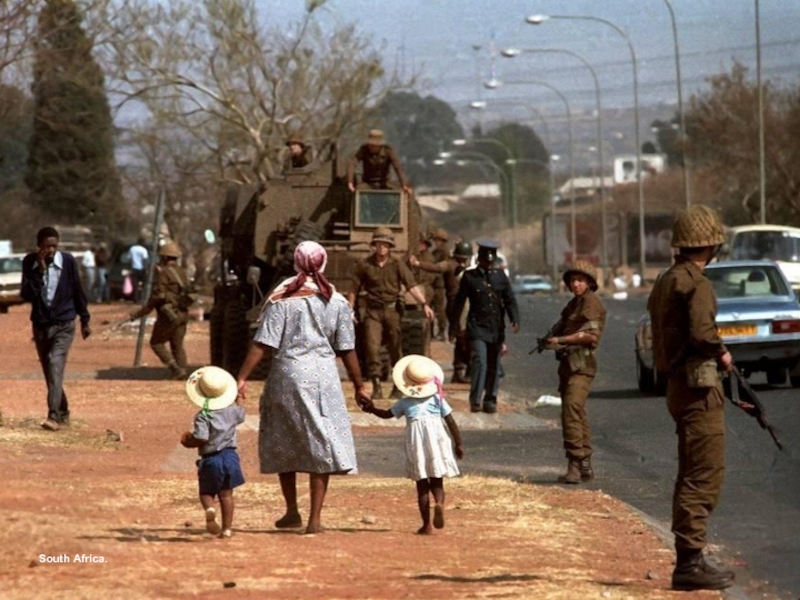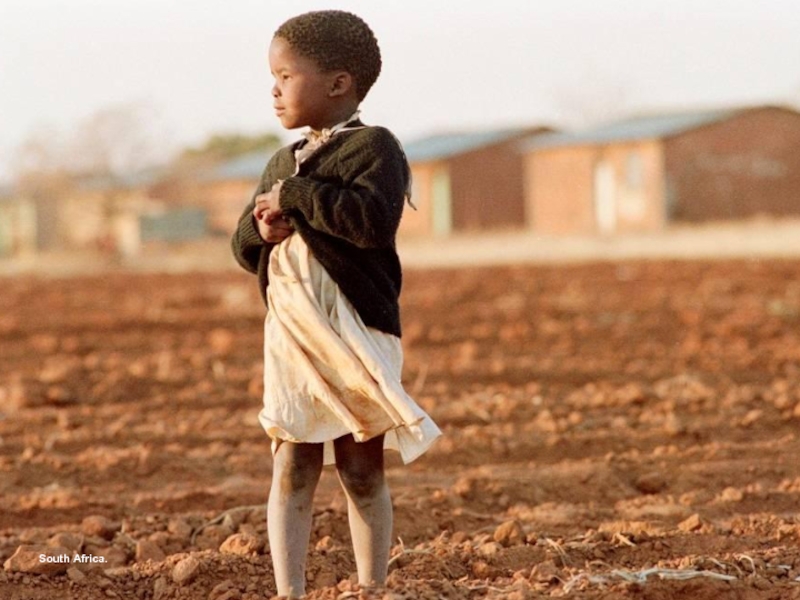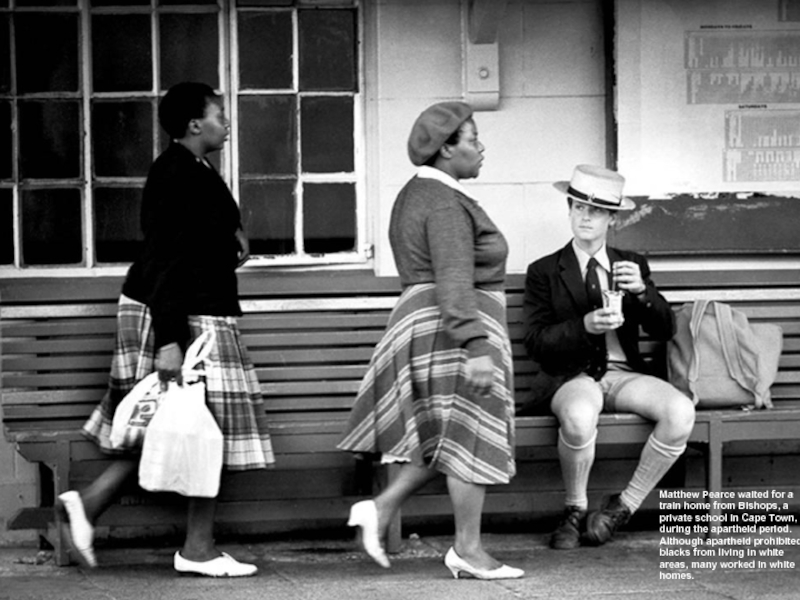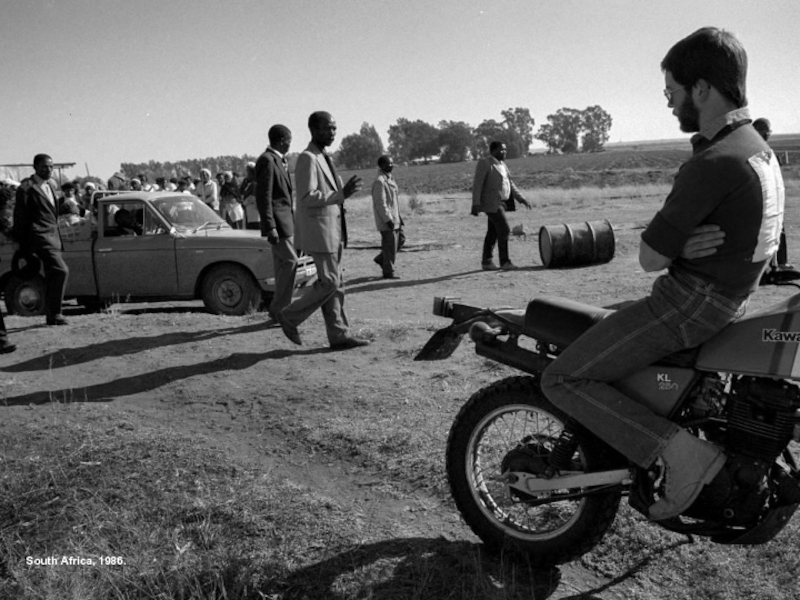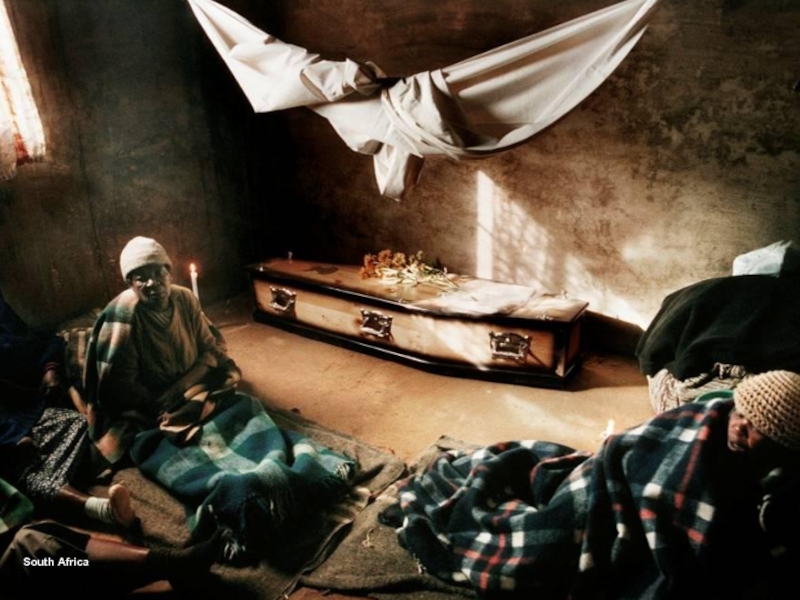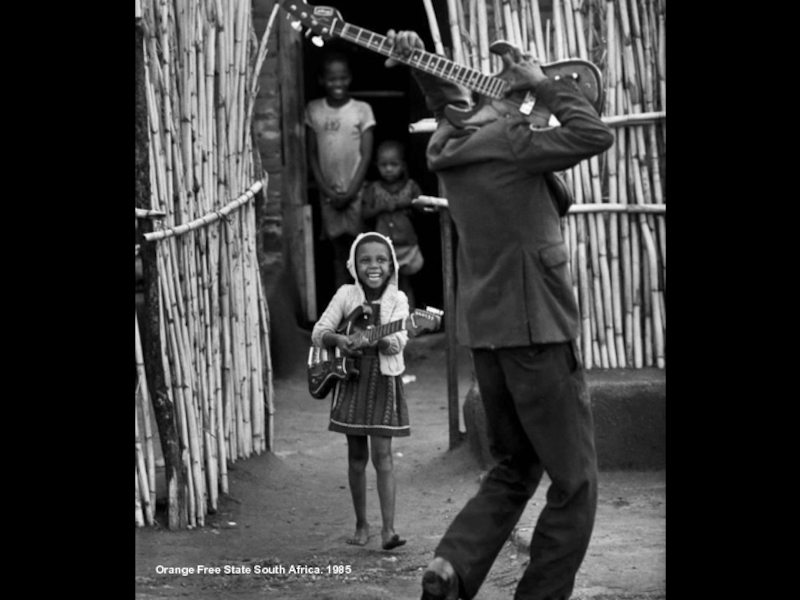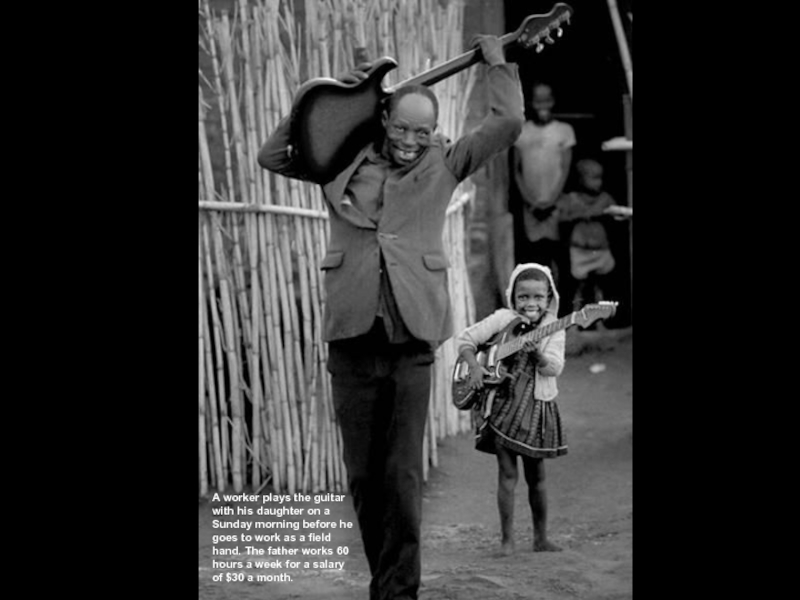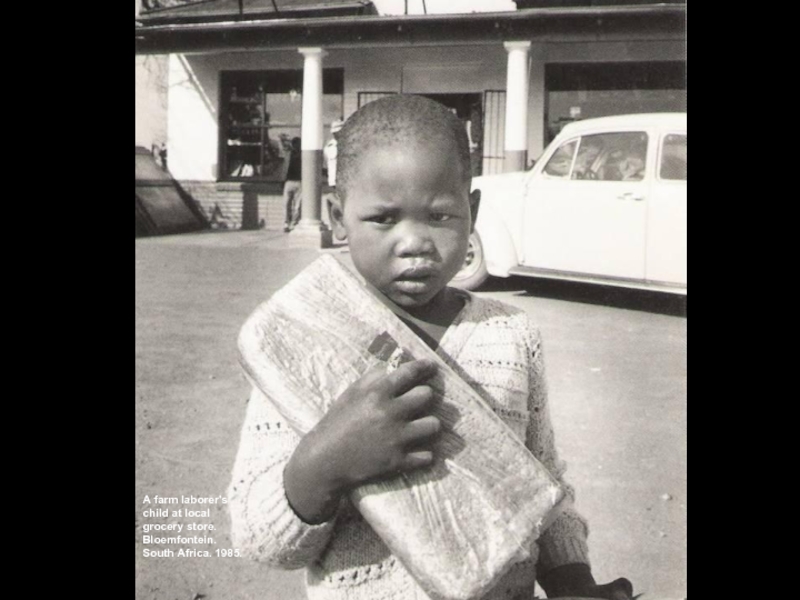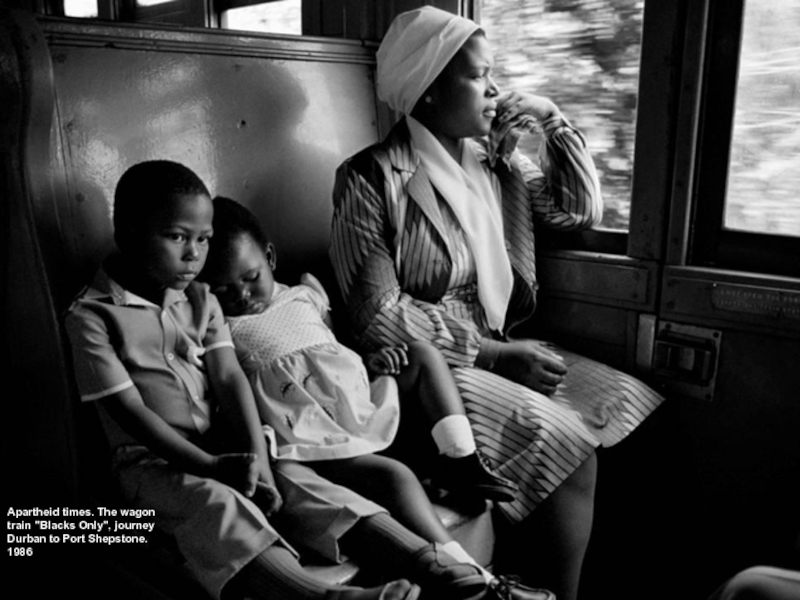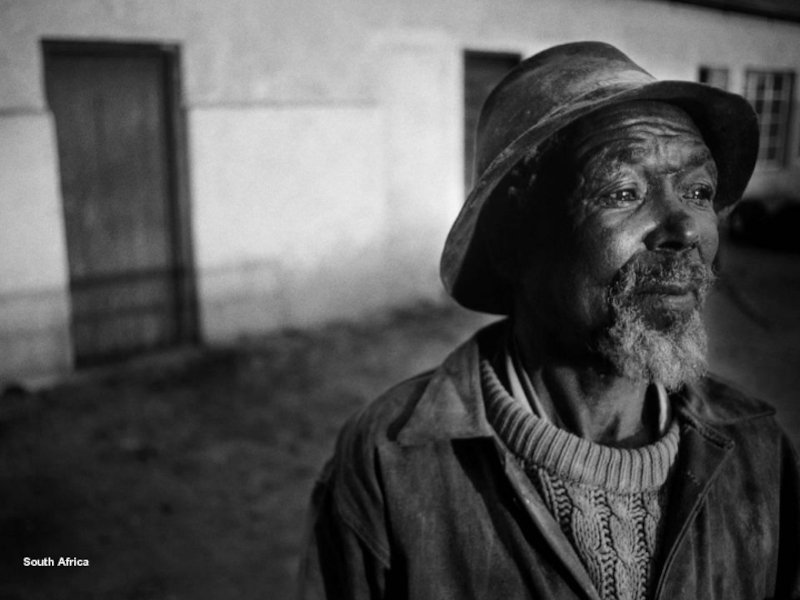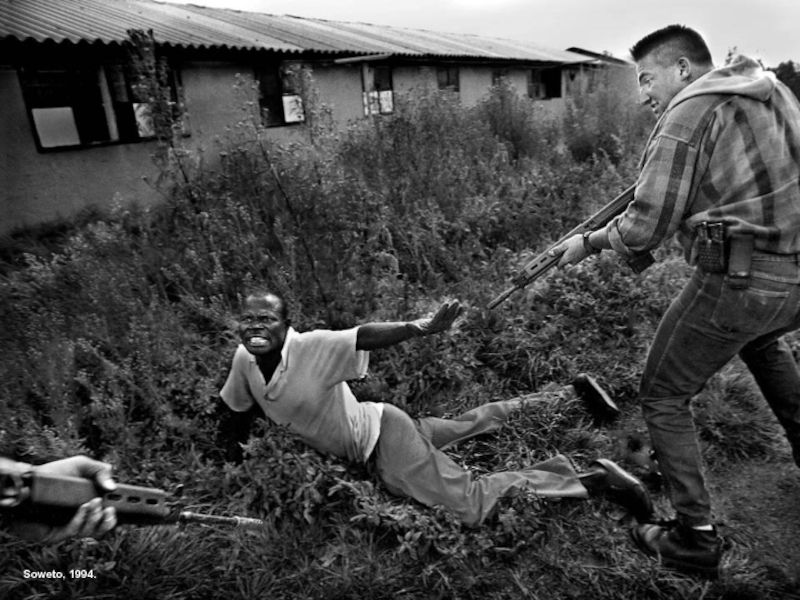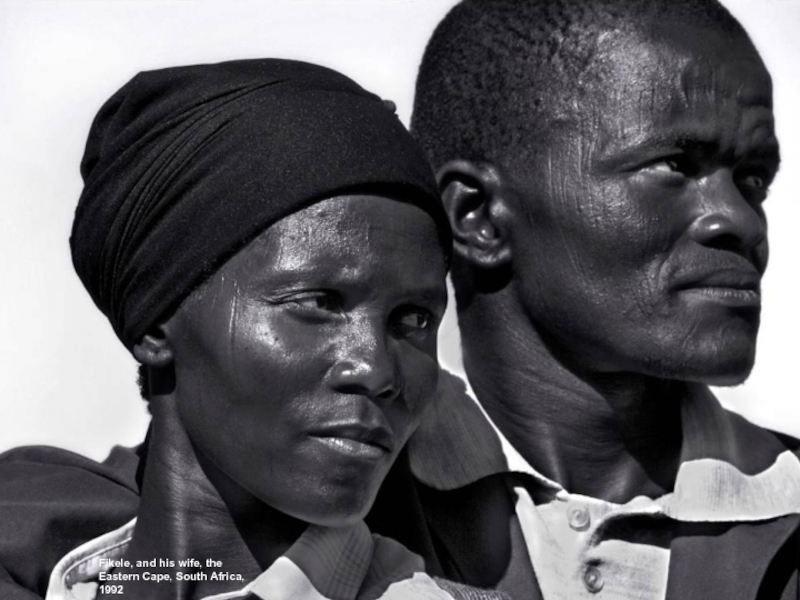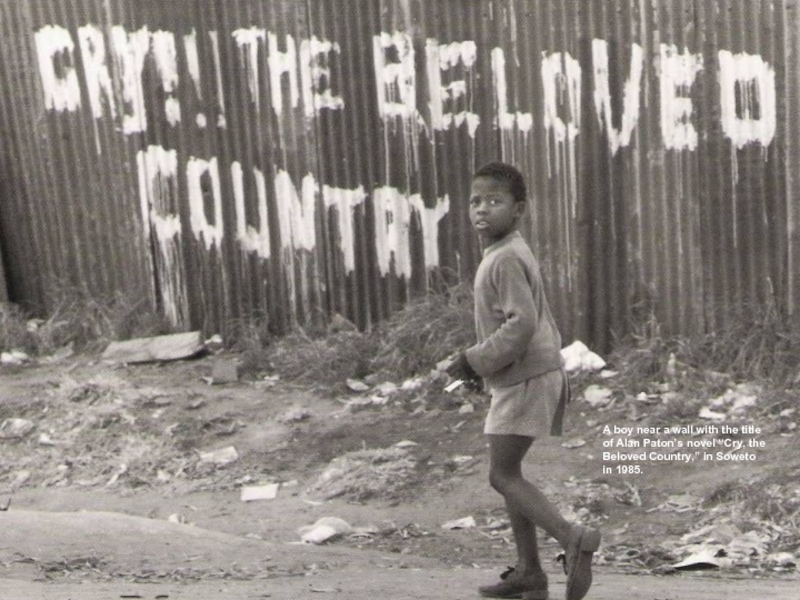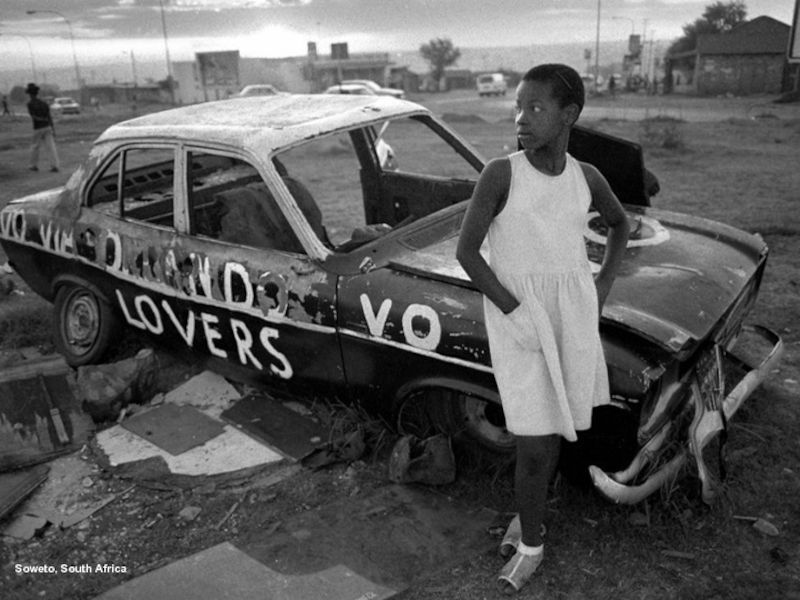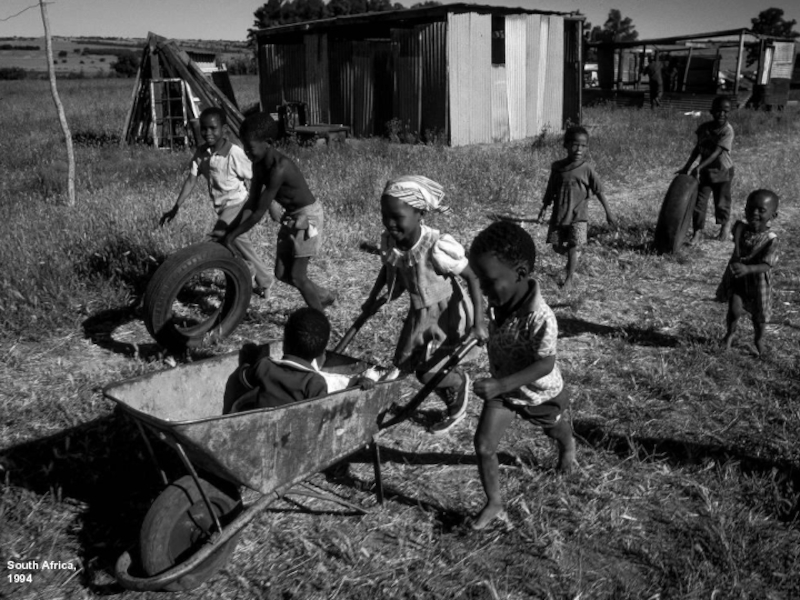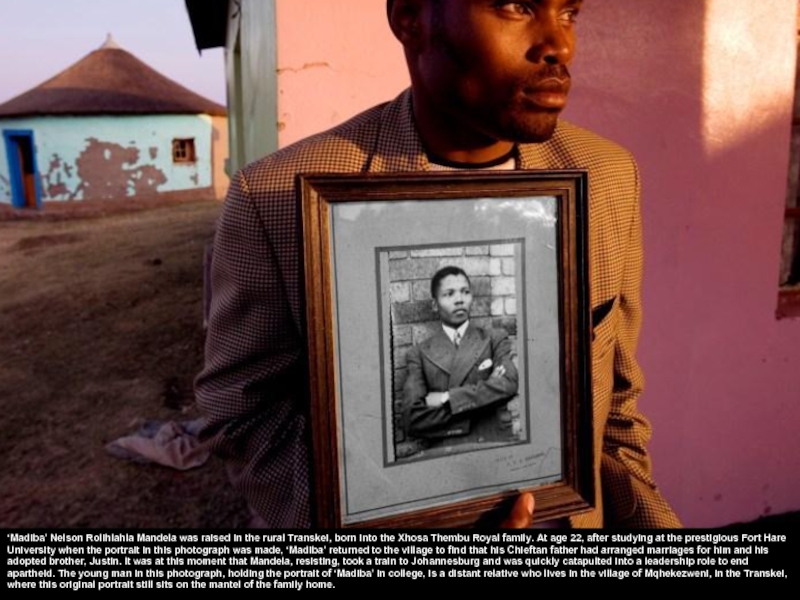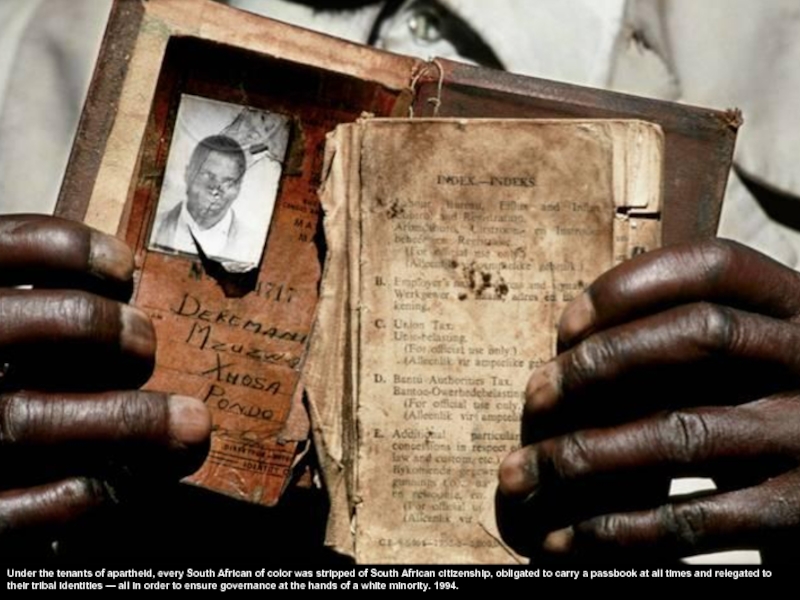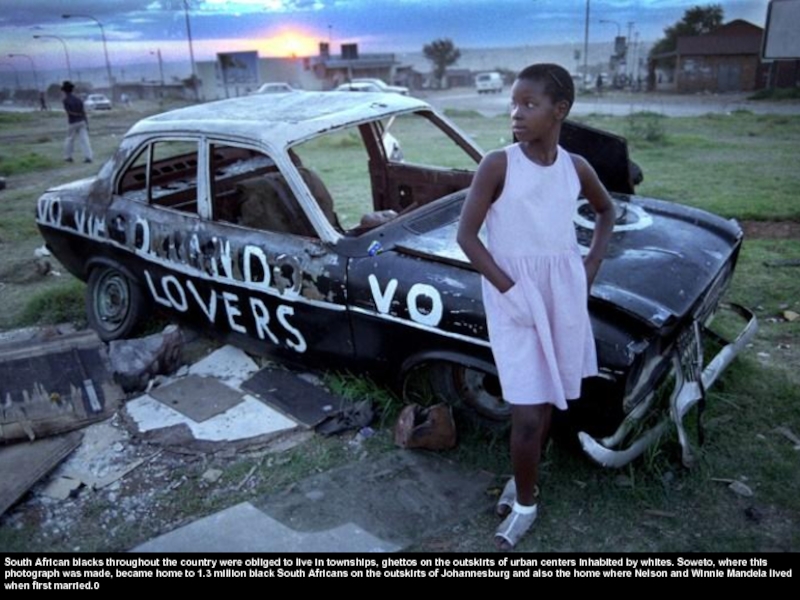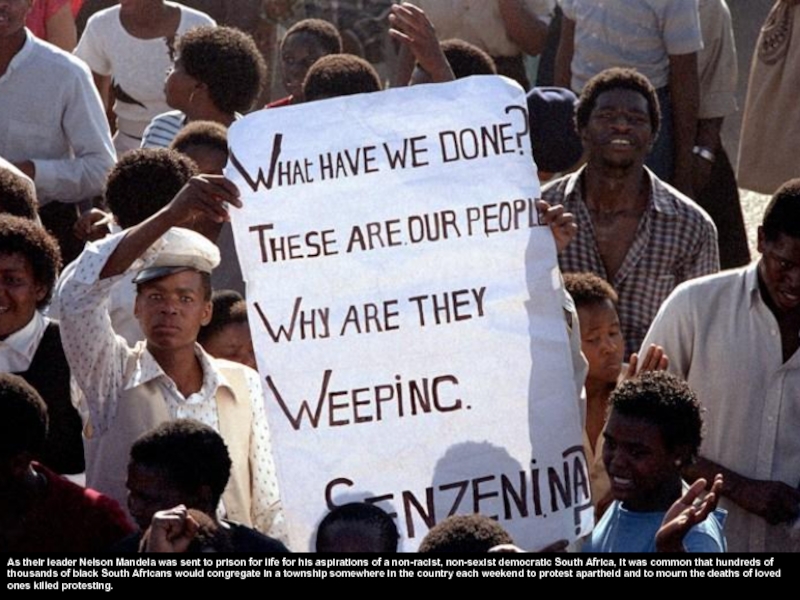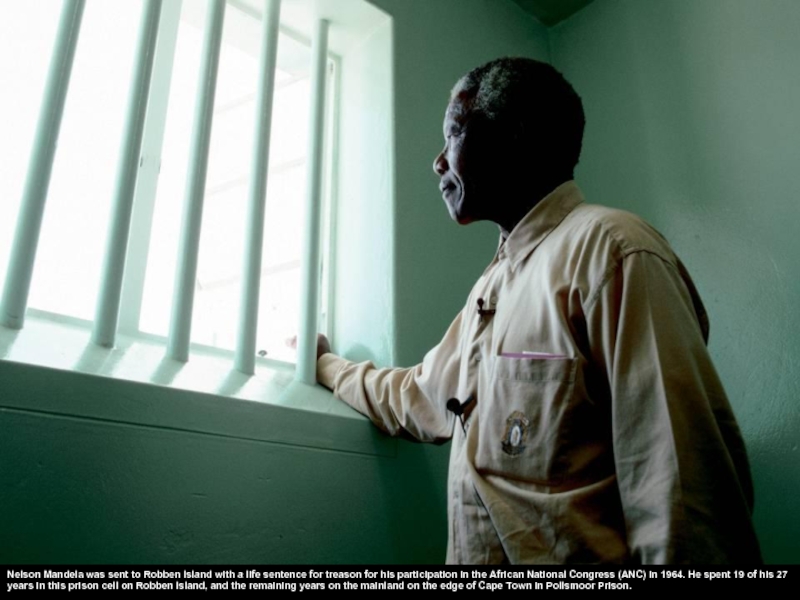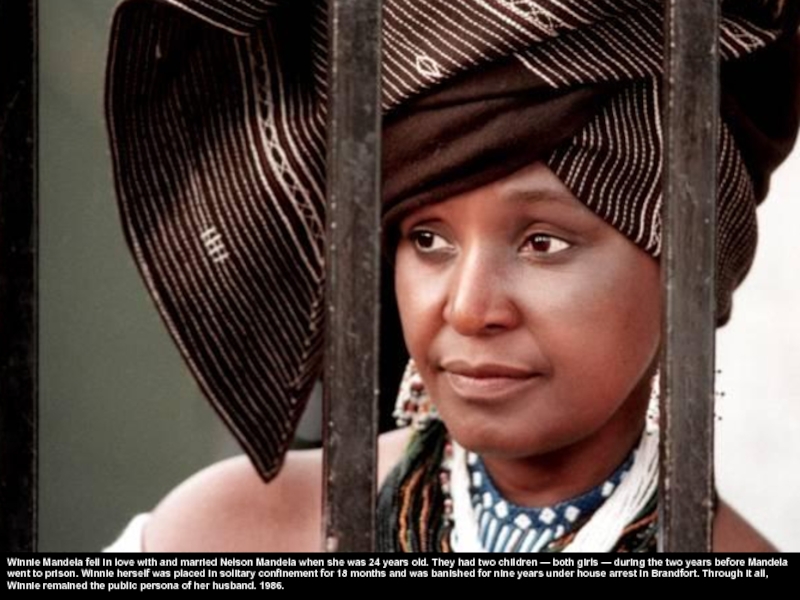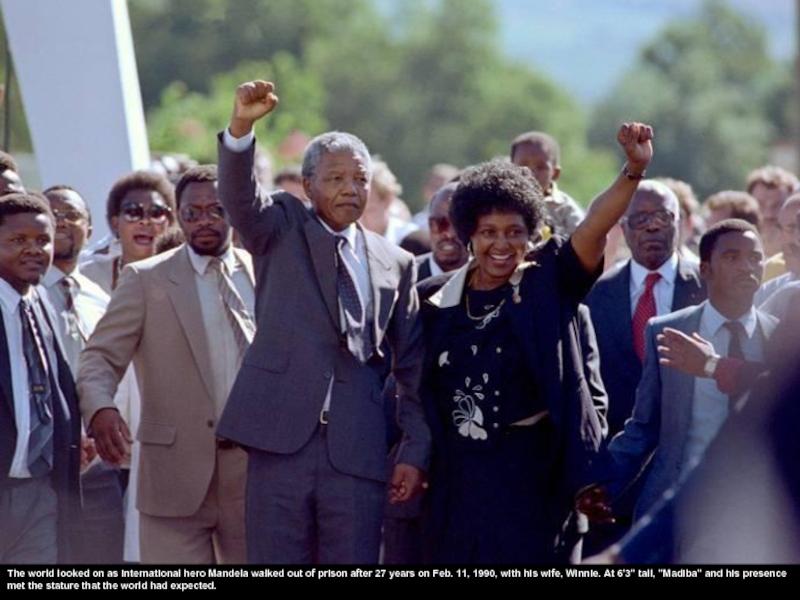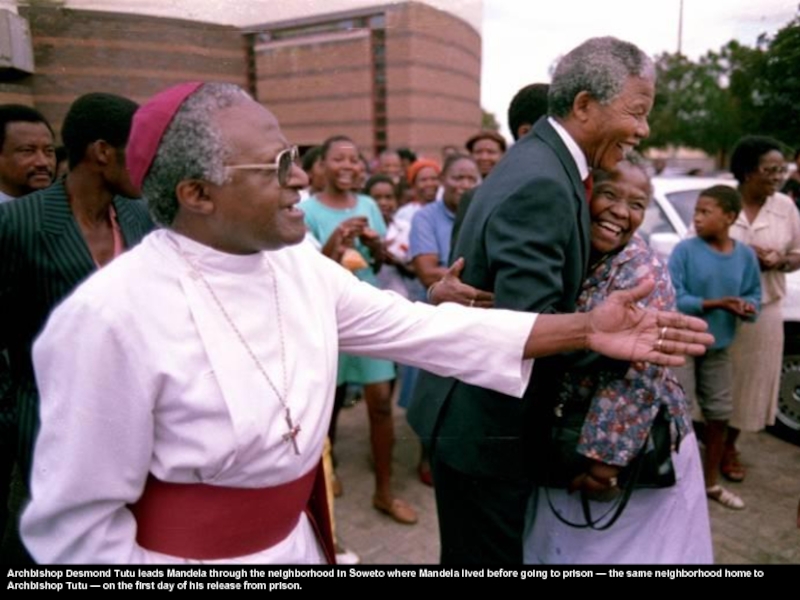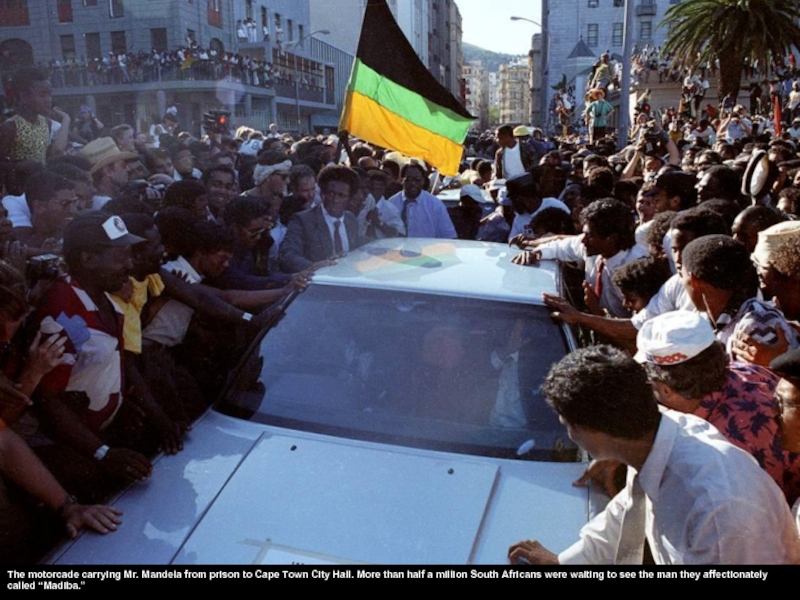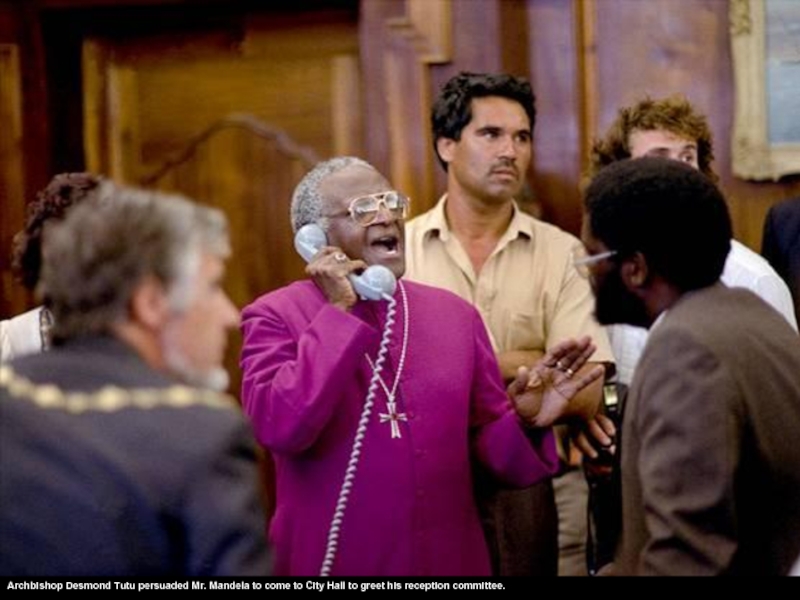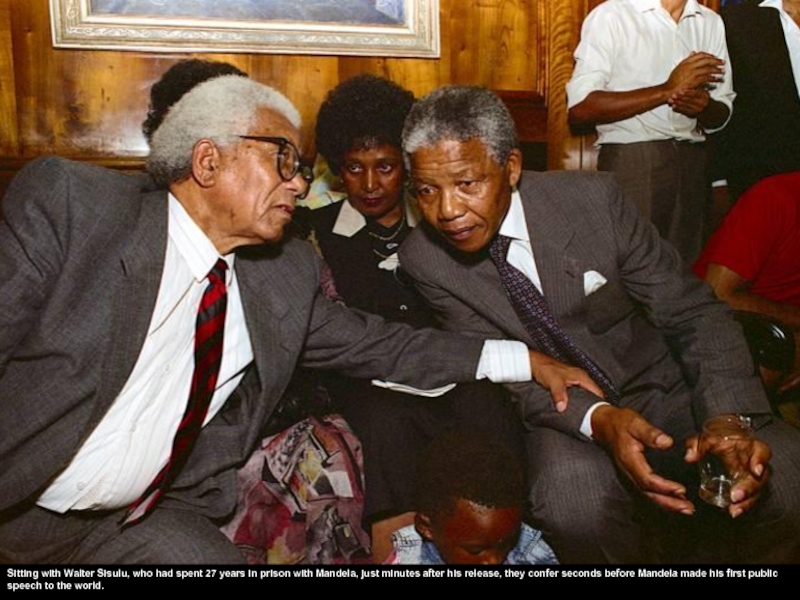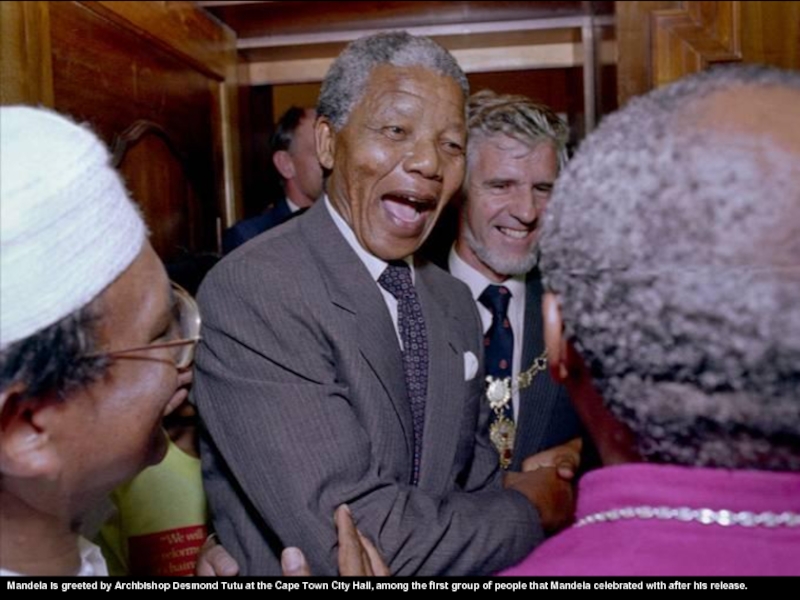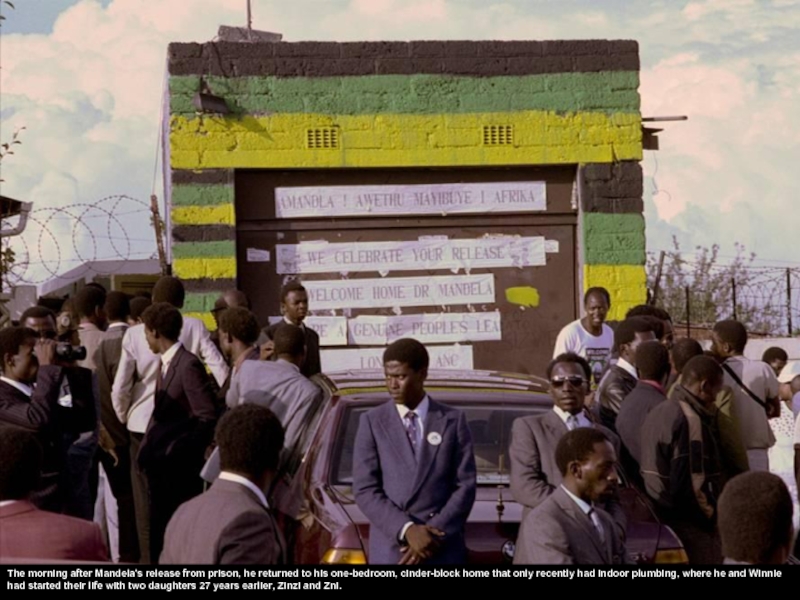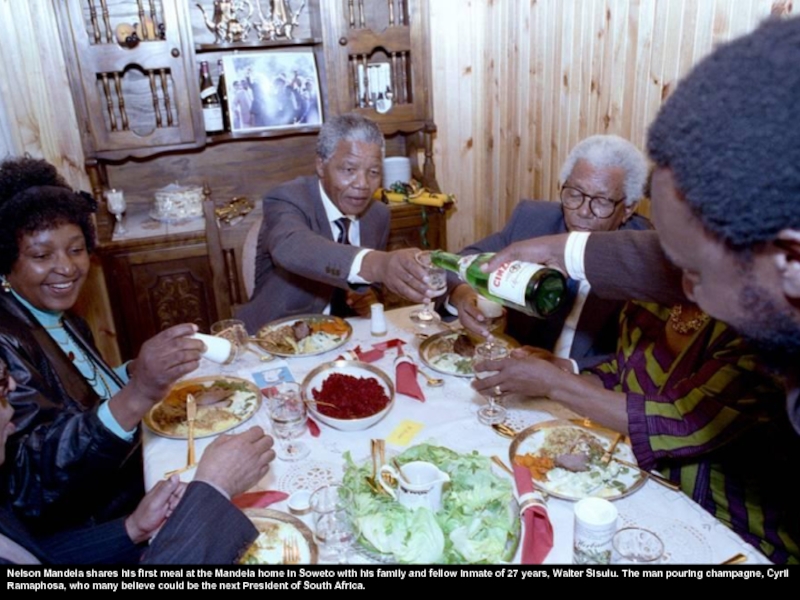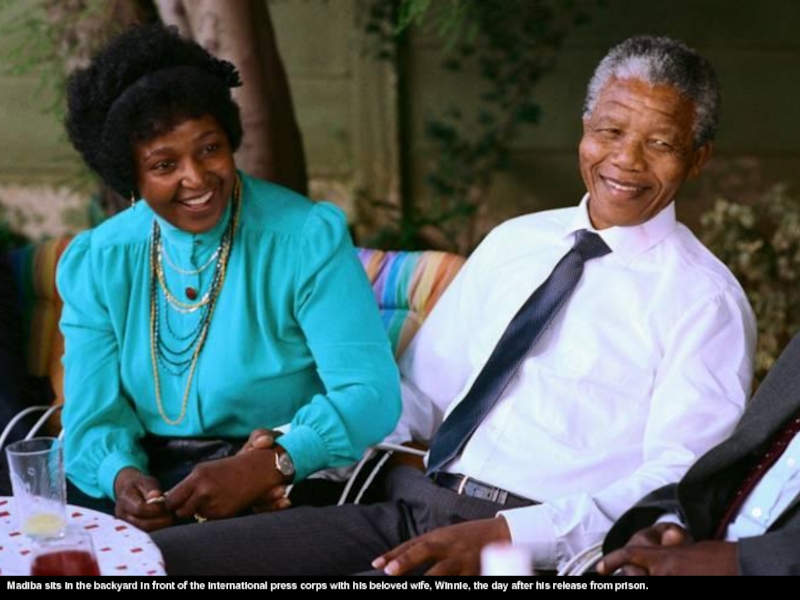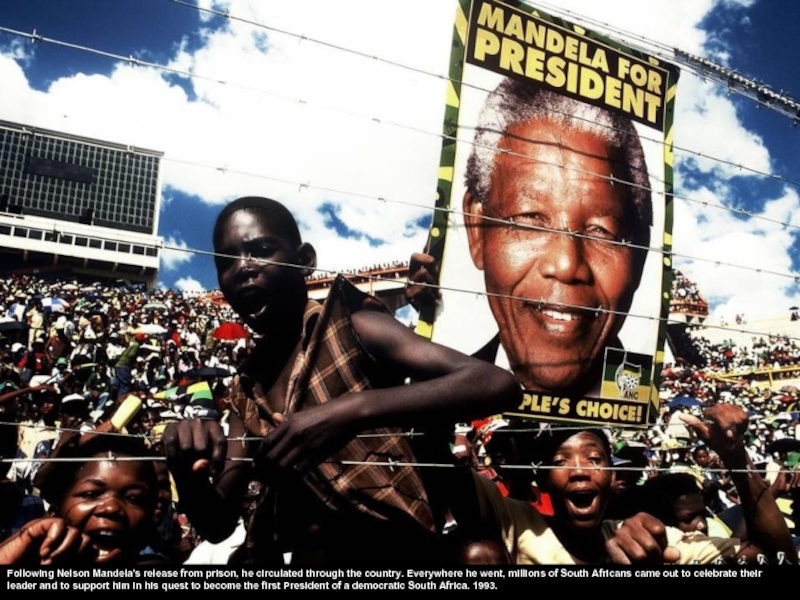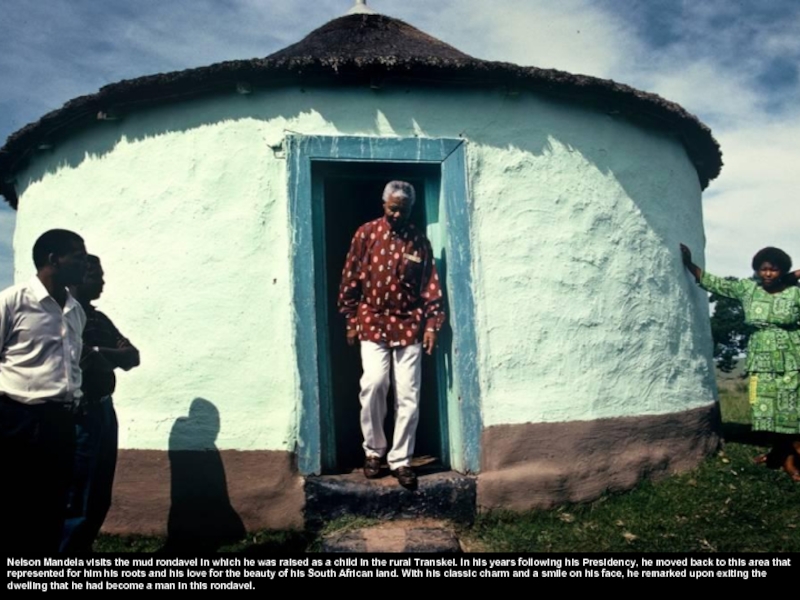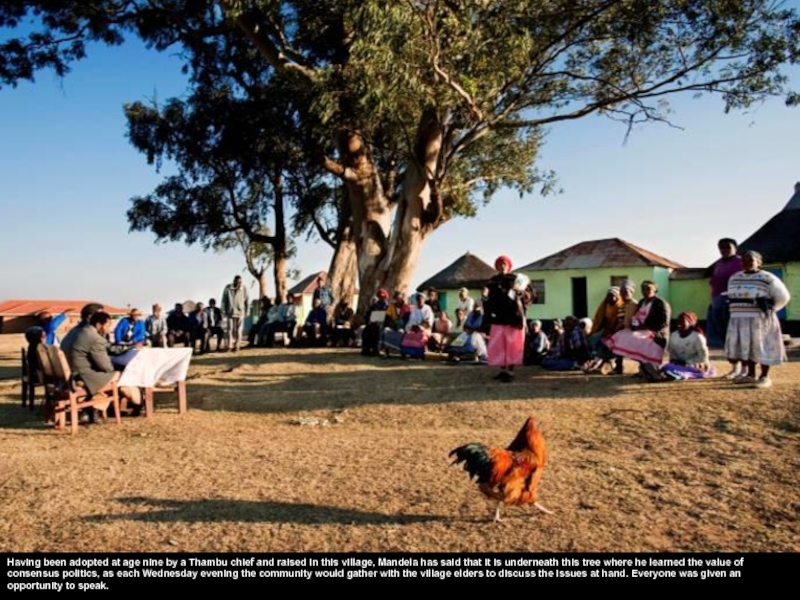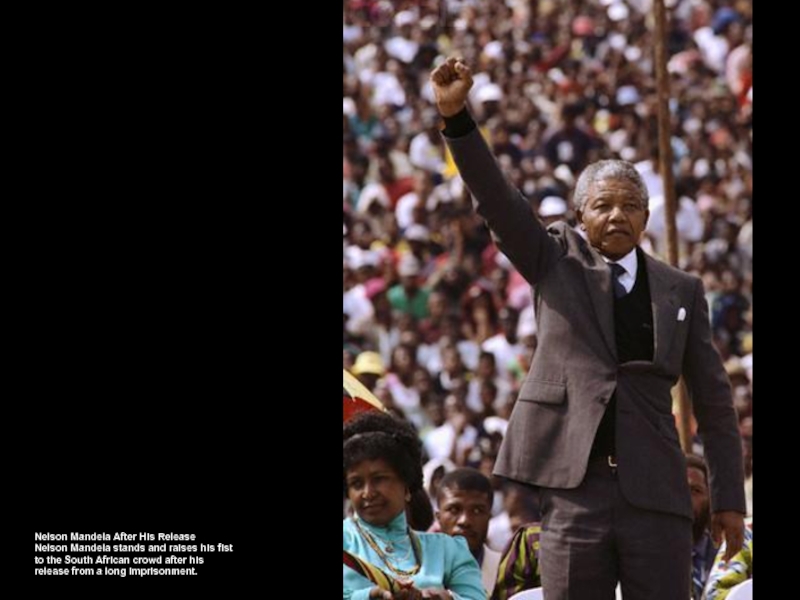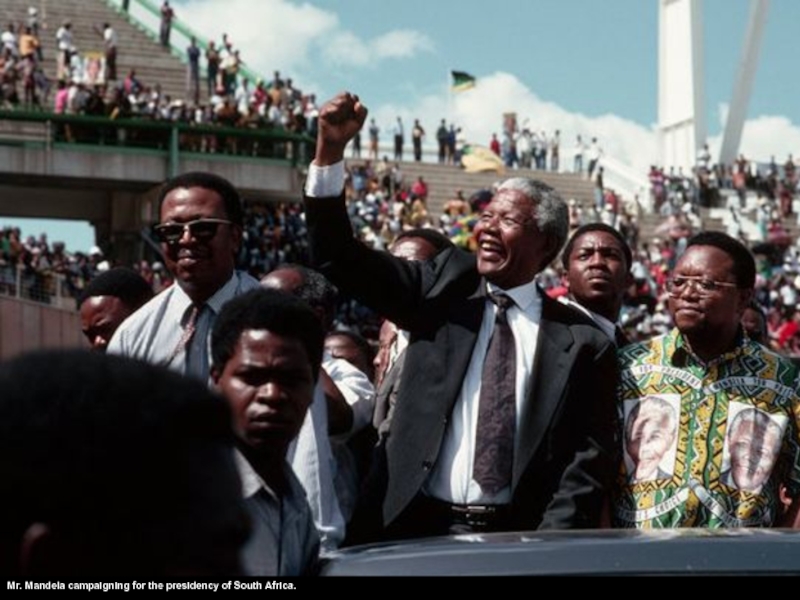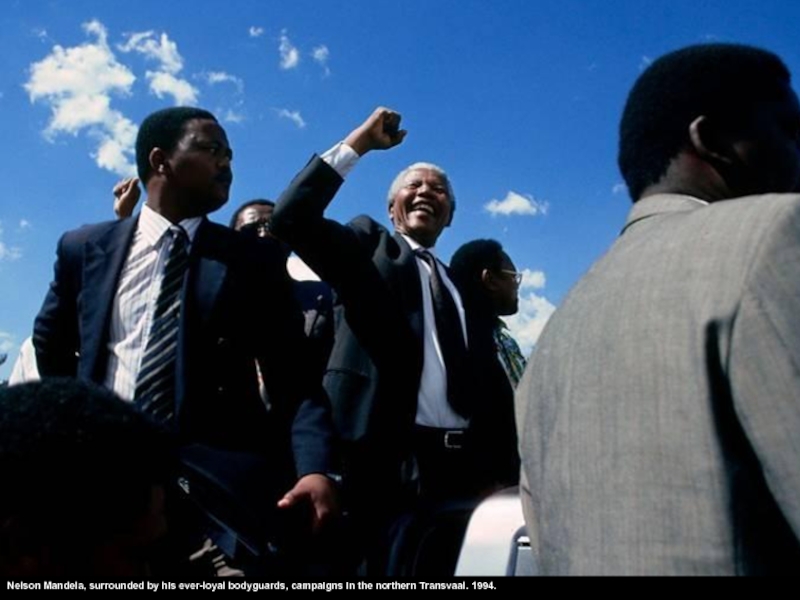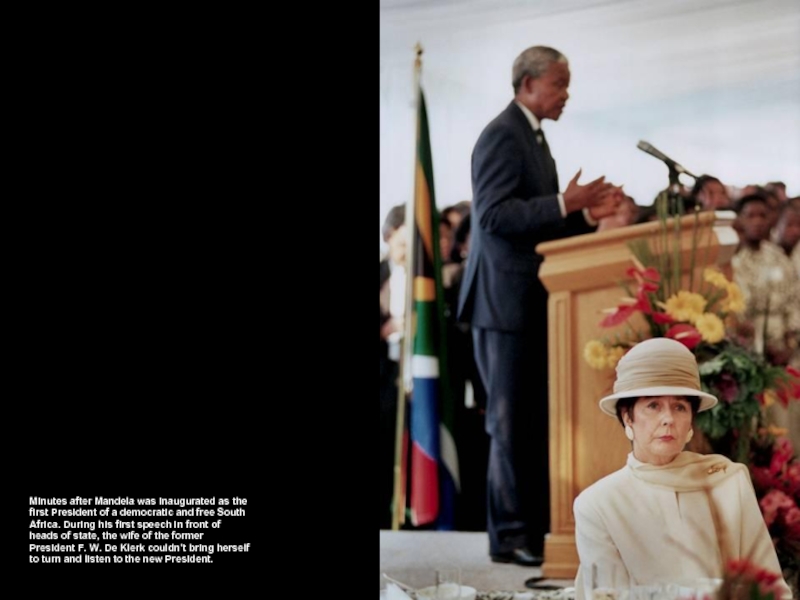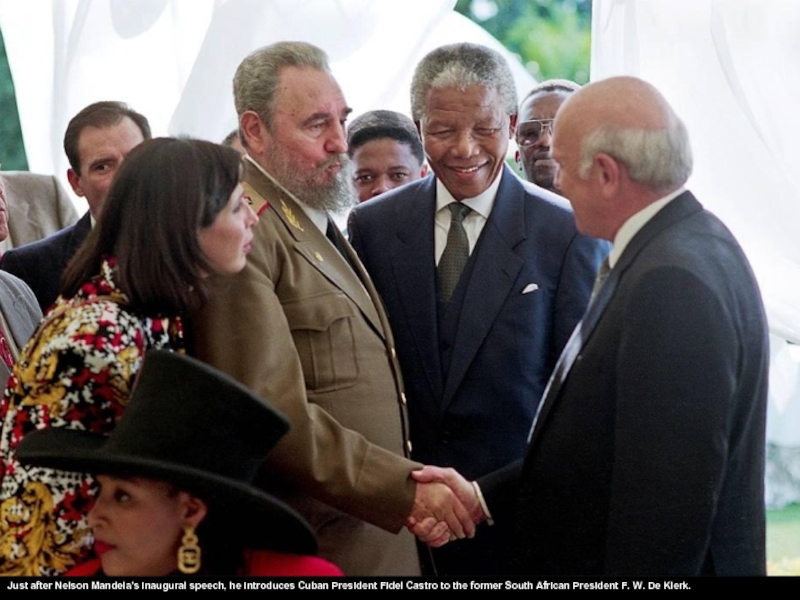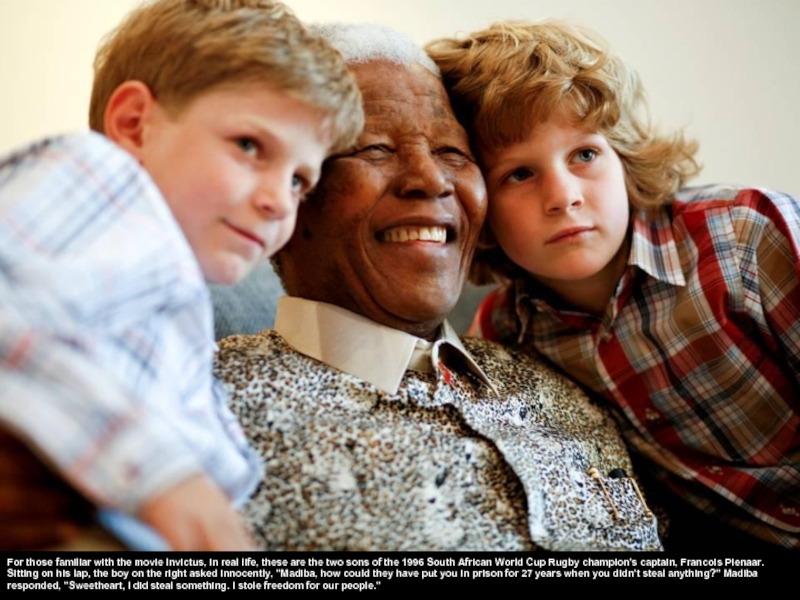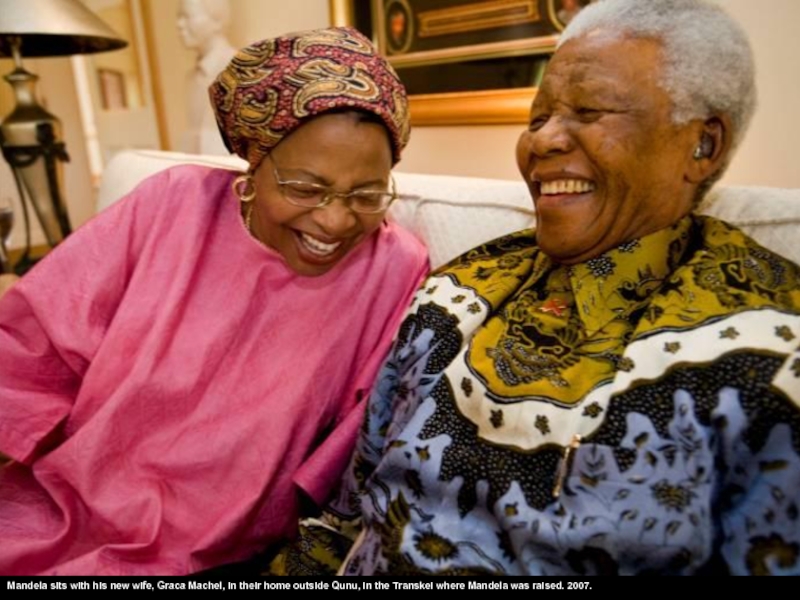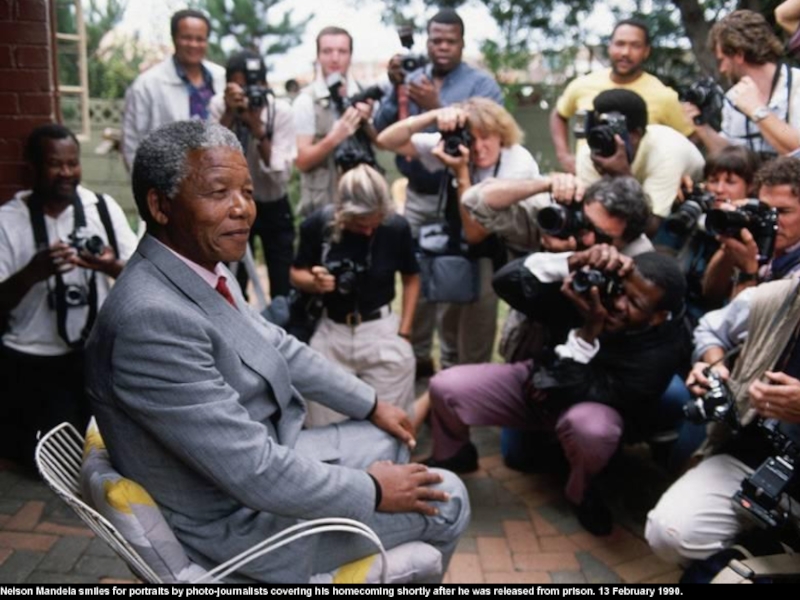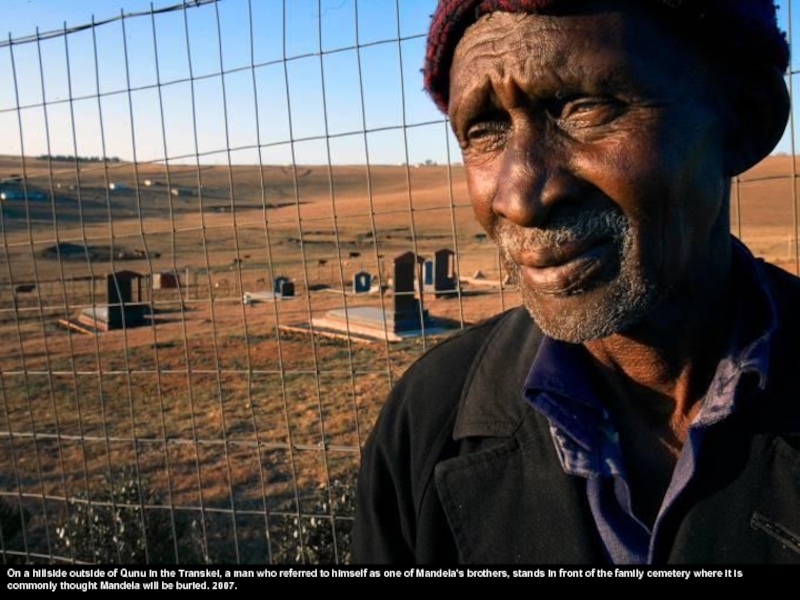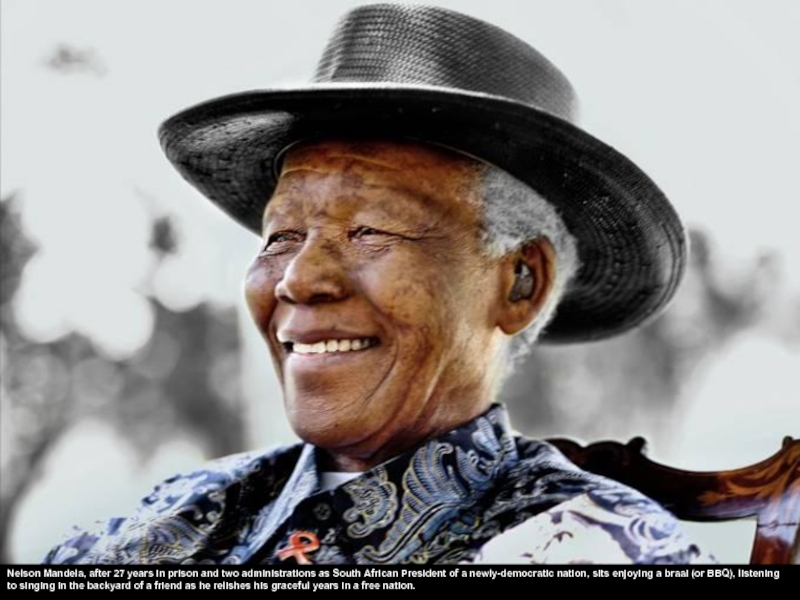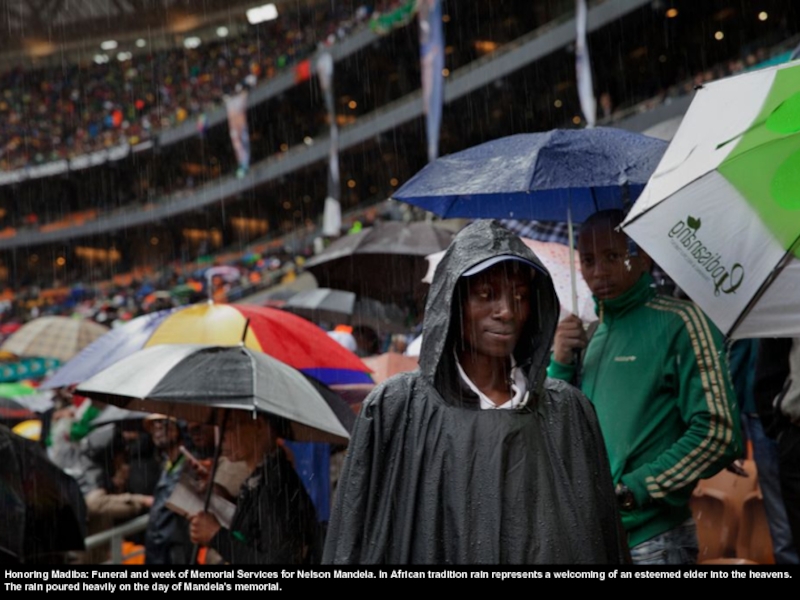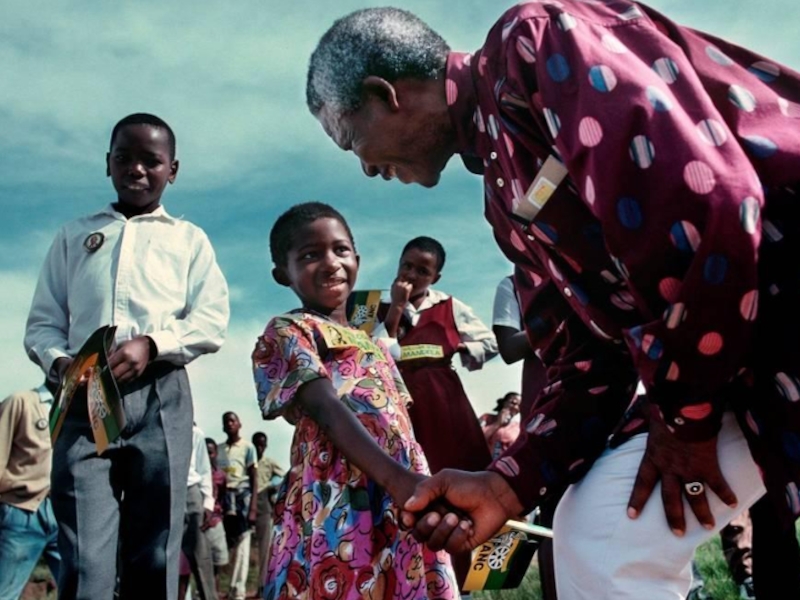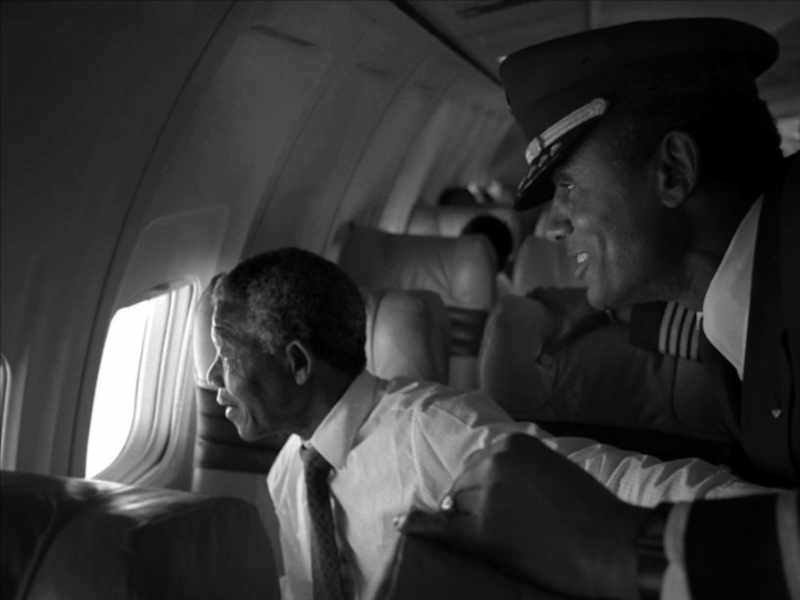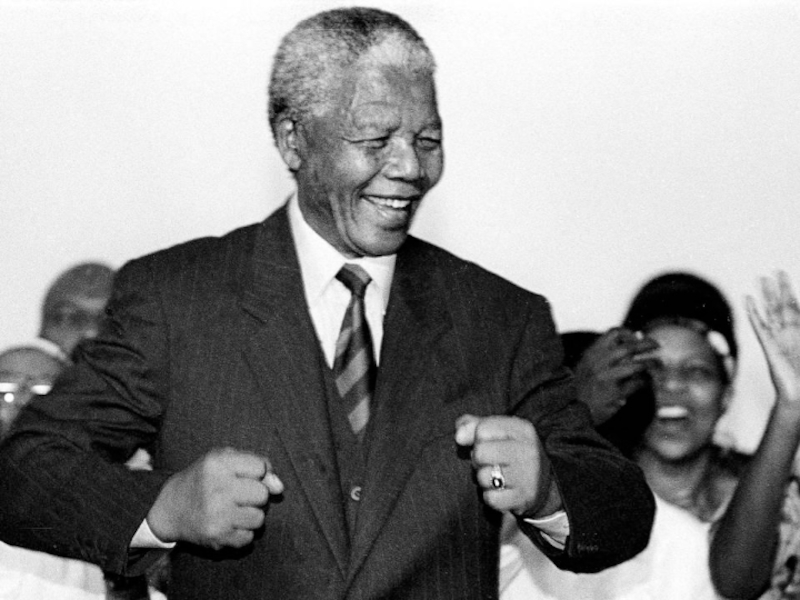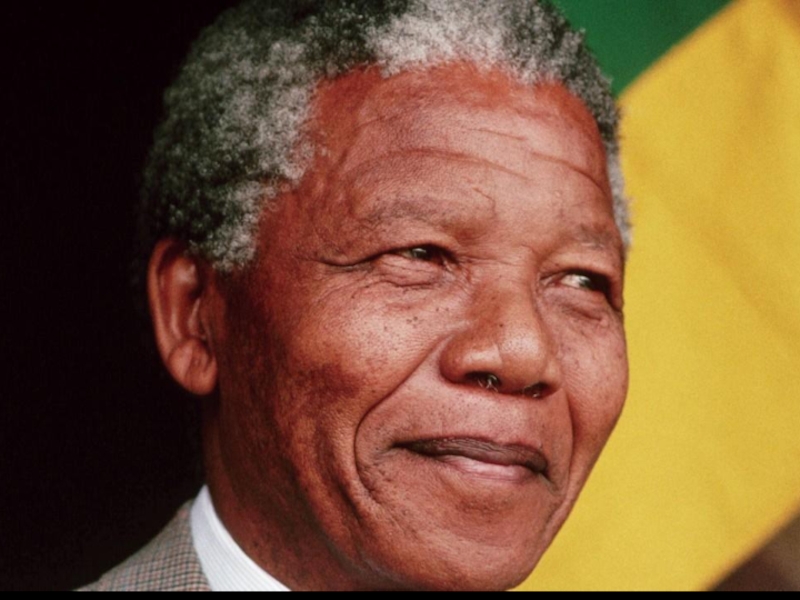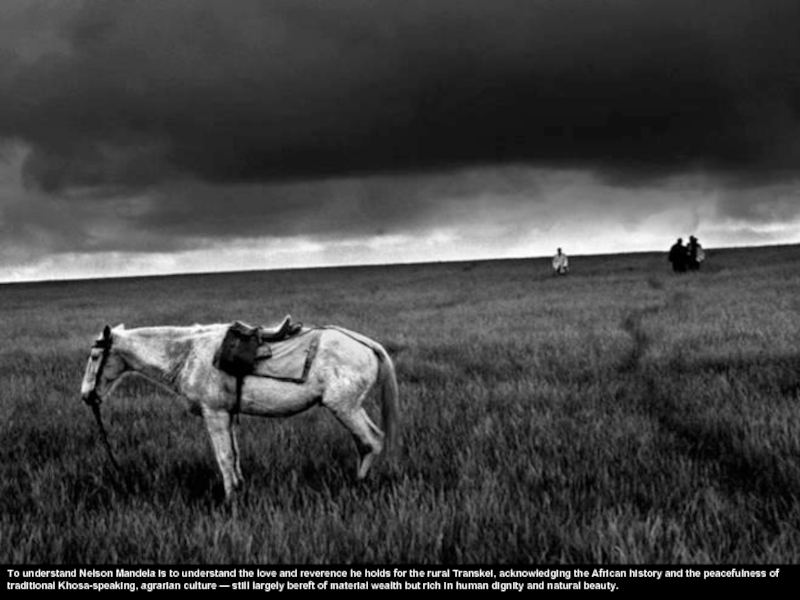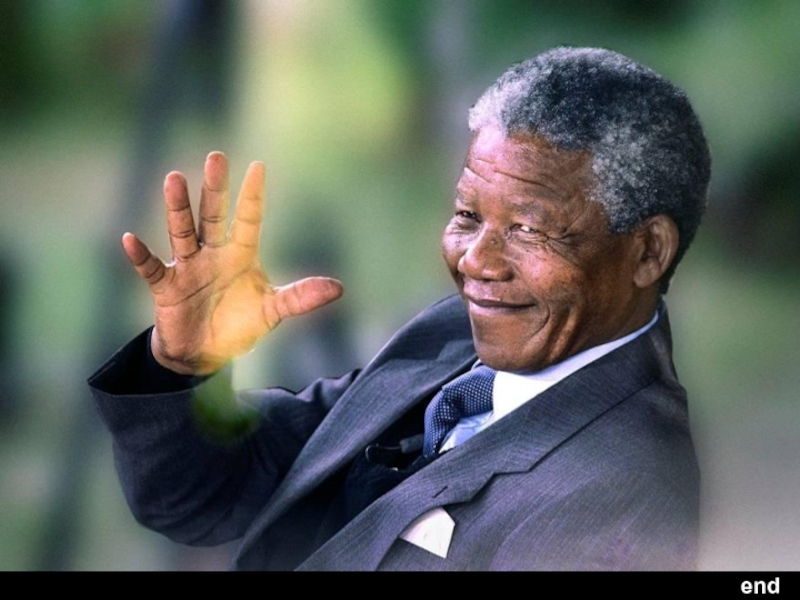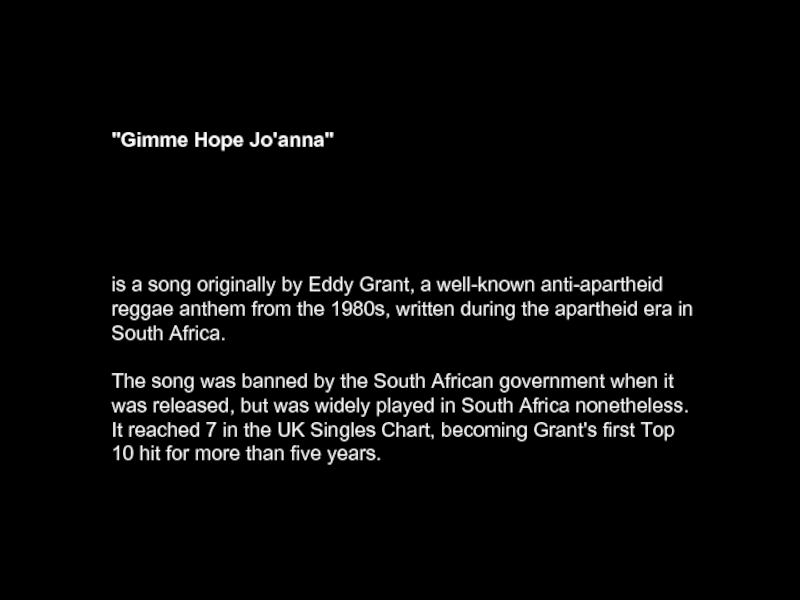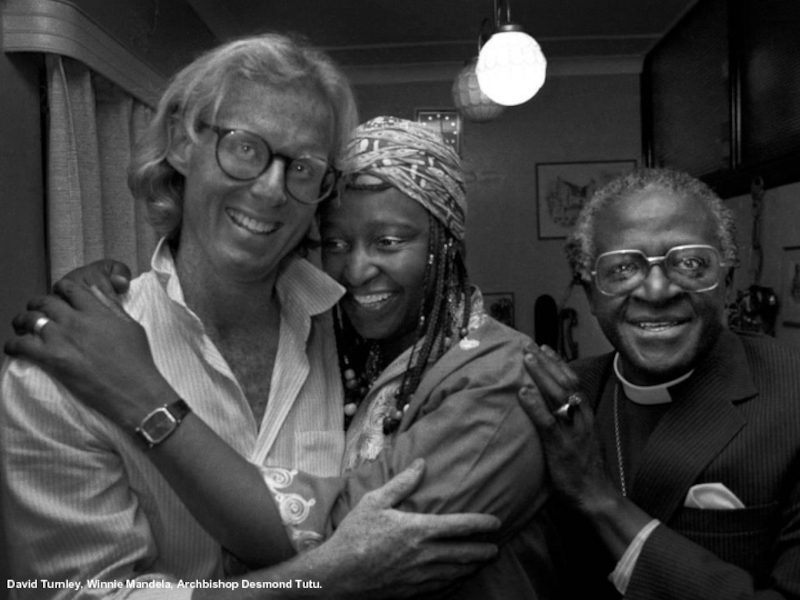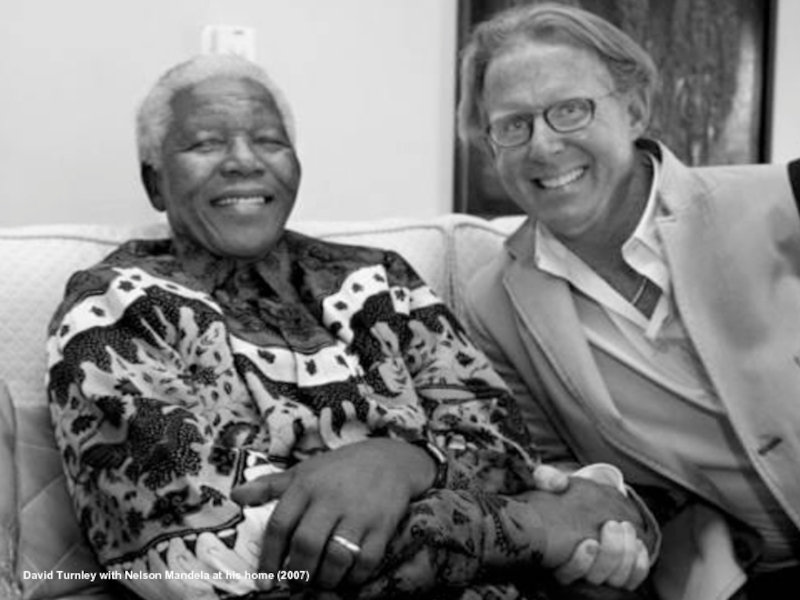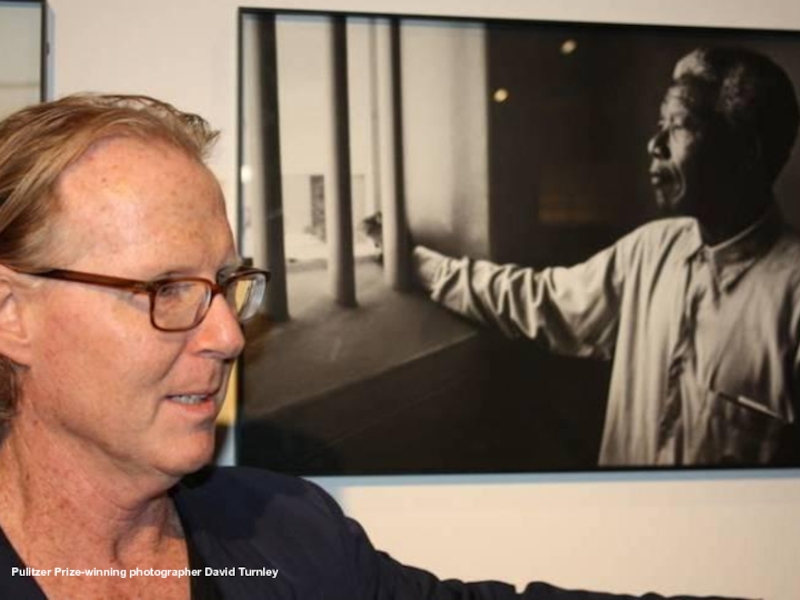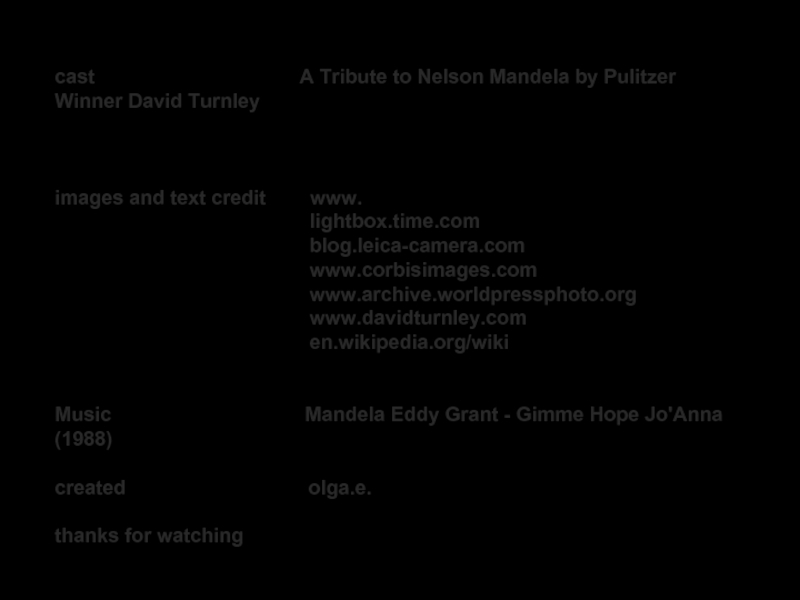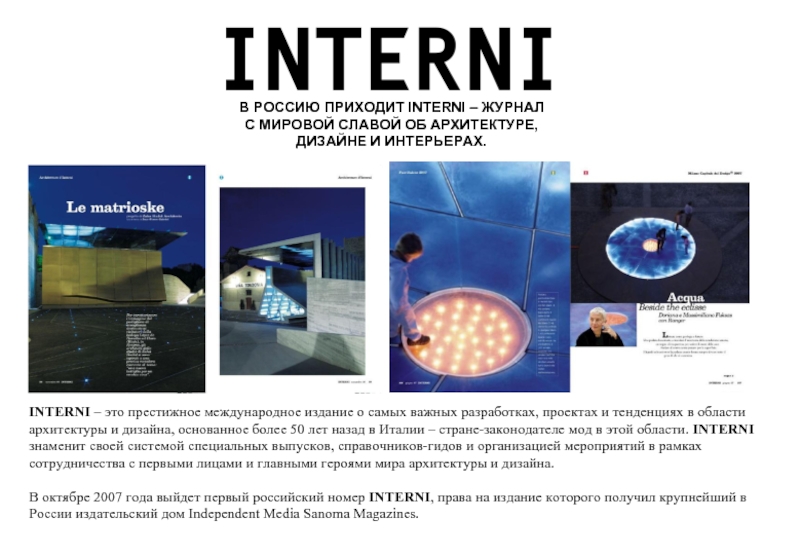- Главная
- Разное
- Дизайн
- Бизнес и предпринимательство
- Аналитика
- Образование
- Развлечения
- Красота и здоровье
- Финансы
- Государство
- Путешествия
- Спорт
- Недвижимость
- Армия
- Графика
- Культурология
- Еда и кулинария
- Лингвистика
- Английский язык
- Астрономия
- Алгебра
- Биология
- География
- Детские презентации
- Информатика
- История
- Литература
- Маркетинг
- Математика
- Медицина
- Менеджмент
- Музыка
- МХК
- Немецкий язык
- ОБЖ
- Обществознание
- Окружающий мир
- Педагогика
- Русский язык
- Технология
- Физика
- Философия
- Химия
- Шаблоны, картинки для презентаций
- Экология
- Экономика
- Юриспруденция
Nelson Mandela on Robben Island. презентация
Содержание
- 1. Nelson Mandela on Robben Island.
- 2. Nelson Mandela on Robben Island, following his release from prison after 27 years.
- 3. A Tribute to Nelson Mandela by Pulitzer Winner David Turnley
- 4. Pulitzer Prize-winning photographer David Turnley spent 28
- 5. He became close to the Mandela
- 7. South Africa.
- 8. South Africa.
- 9. Matthew Pearce waited for a train
- 10. South Africa, 1986.
- 11. South Africa
- 12. Orange Free State South Africa. 1985
- 13. A worker plays the guitar with his
- 14. A farm laborer's child at local grocery store. Bloemfontein. South Africa. 1985.
- 15. Apartheid times. The wagon train "Blacks Only", journey Durban to Port Shepstone. 1986
- 16. South Africa
- 17. Soweto, 1994.
- 18. Fikele, and his wife, the Eastern Cape, South Africa, 1992
- 19. A boy near a wall with the
- 20. Soweto, South Africa
- 21. South Africa, 1994
- 22. ‘Madiba’ Nelson Rolihlahla Mandela was raised in
- 23. Under the tenants of apartheid, every South
- 24. South African blacks throughout the country were
- 25. As their leader Nelson Mandela was sent
- 26. Nelson Mandela was sent to Robben Island
- 27. Winnie Mandela fell in love with and
- 28. Black South Africans mourn the deaths of
- 29. The world looked on as international hero
- 30. Archbishop Desmond Tutu leads Mandela through the
- 31. The motorcade carrying Mr. Mandela from prison
- 32. Archbishop Desmond Tutu persuaded Mr. Mandela to
- 33. Sitting with Walter Sisulu, who had spent
- 34. Mandela is greeted by Archbishop Desmond Tutu
- 35. The morning after Mandela's release from prison,
- 36. Nelson Mandela shares his first meal at
- 37. Madiba sits in the backyard in front
- 38. Following Nelson Mandela's release from prison, he
- 39. Nelson Mandela visits the mud rondavel in
- 40. Having been adopted at age nine by
- 41. Nelson Mandela After His Release Nelson Mandela
- 42. Mr. Mandela campaigning for the presidency of South Africa.
- 43. Nelson Mandela, surrounded by his ever-loyal bodyguards, campaigns in the northern Transvaal. 1994.
- 44. Minutes after Mandela was inaugurated as the
- 45. Just after Nelson Mandela's inaugural speech, he
- 46. For those familiar with the movie Invictus,
- 47. Mandela sits with his new wife, Graca
- 48. Nelson Mandela smiles for portraits by photo-journalists
- 49. On a hillside outside of Qunu in
- 50. Nelson Mandela, after 27 years in prison
- 51. Honoring Madiba: Funeral and week of Memorial
- 56. To understand Nelson Mandela is to understand
- 57. end
- 58. "Gimme Hope Jo'anna"
- 59. David Turnley, Winnie Mandela, Archbishop Desmond Tutu.
- 60. David Turnley with Nelson Mandela at his home (2007)
- 61. Pulitzer Prize-winning photographer David Turnley
- 62. cast
Слайд 4Pulitzer Prize-winning photographer David Turnley spent 28 years photographing South Africa’s
struggles of apartheid.
Having documented the life of Nelson Mandela and his people, Turnley reflects on his memories of Mandela on the day of his release from prison.
Having documented the life of Nelson Mandela and his people, Turnley reflects on his memories of Mandela on the day of his release from prison.
Слайд 5
He became close to the Mandela family while photographing Winnie Mandela
for LIFE magazine. Pretending to be a lawyer, he accompanied her to Pollsmoor Prison, where he glimpsed a silhouette of Nelson Mandela during his final years in prison. It was a powerful and “dreamlike experience.”
Mr. Turnley has since captured some of the most iconic images of the anti-apartheid leader: intimate moments after his release in 1990, his campaign for president and his quest to end South Africa’s brutally codified system of racial domination.
Mr. Turnley has since captured some of the most iconic images of the anti-apartheid leader: intimate moments after his release in 1990, his campaign for president and his quest to end South Africa’s brutally codified system of racial domination.
Слайд 9
Matthew Pearce waited for a train home from Bishops, a private
school in Cape Town, during the apartheid period. Although apartheid prohibited blacks from living in white areas, many worked in white homes.
Слайд 13A worker plays the guitar with his daughter on a Sunday
morning before he goes to work as a field hand. The father works 60 hours a week for a salary of $30 a month.
Слайд 19A boy near a wall with the title of Alan Paton’s
novel “Cry, the Beloved Country,” in Soweto in 1985.
Слайд 22‘Madiba’ Nelson Rolihlahla Mandela was raised in the rural Transkei, born
into the Xhosa Thembu Royal family. At age 22, after studying at the prestigious Fort Hare University when the portrait in this photograph was made, ‘Madiba’ returned to the village to find that his Chieftan father had arranged marriages for him and his adopted brother, Justin. It was at this moment that Mandela, resisting, took a train to Johannesburg and was quickly catapulted into a leadership role to end apartheid. The young man in this photograph, holding the portrait of ‘Madiba’ in college, is a distant relative who lives in the village of Mqhekezweni, in the Transkei, where this original portrait still sits on the mantel of the family home.
Слайд 23Under the tenants of apartheid, every South African of color was
stripped of South African citizenship, obligated to carry a passbook at all times and relegated to their tribal identities — all in order to ensure governance at the hands of a white minority. 1994.
Слайд 24South African blacks throughout the country were obliged to live in
townships, ghettos on the outskirts of urban centers inhabited by whites. Soweto, where this photograph was made, became home to 1.3 million black South Africans on the outskirts of Johannesburg and also the home where Nelson and Winnie Mandela lived when first married.0
Слайд 25As their leader Nelson Mandela was sent to prison for life
for his aspirations of a non-racist, non-sexist democratic South Africa, it was common that hundreds of thousands of black South Africans would congregate in a township somewhere in the country each weekend to protest apartheid and to mourn the deaths of loved ones killed protesting.
Слайд 26Nelson Mandela was sent to Robben Island with a life sentence
for treason for his participation in the African National Congress (ANC) in 1964. He spent 19 of his 27 years in this prison cell on Robben Island, and the remaining years on the mainland on the edge of Cape Town in Pollsmoor Prison.
Слайд 27Winnie Mandela fell in love with and married Nelson Mandela when
she was 24 years old. They had two children — both girls — during the two years before Mandela went to prison. Winnie herself was placed in solitary confinement for 18 months and was banished for nine years under house arrest in Brandfort. Through it all, Winnie remained the public persona of her husband. 1986.
Слайд 28Black South Africans mourn the deaths of anti-apartheid protestors in Duncan
Village, a township outside of East London, South Africa. 1986.
Слайд 29The world looked on as international hero Mandela walked out of
prison after 27 years on Feb. 11, 1990, with his wife, Winnie. At 6'3" tall, "Madiba" and his presence met the stature that the world had expected.
Слайд 30Archbishop Desmond Tutu leads Mandela through the neighborhood in Soweto where
Mandela lived before going to prison — the same neighborhood home to Archbishop Tutu — on the first day of his release from prison.
Слайд 31The motorcade carrying Mr. Mandela from prison to Cape Town City
Hall. More than half a million South Africans were waiting to see the man they affectionately called “Madiba.”
Слайд 32Archbishop Desmond Tutu persuaded Mr. Mandela to come to City Hall
to greet his reception committee.
Слайд 33Sitting with Walter Sisulu, who had spent 27 years in prison
with Mandela, just minutes after his release, they confer seconds before Mandela made his first public speech to the world.
Слайд 34Mandela is greeted by Archbishop Desmond Tutu at the Cape Town
City Hall, among the first group of people that Mandela celebrated with after his release.
Слайд 35The morning after Mandela's release from prison, he returned to his
one-bedroom, cinder-block home that only recently had indoor plumbing, where he and Winnie had started their life with two daughters 27 years earlier, Zinzi and Zni.
Слайд 36Nelson Mandela shares his first meal at the Mandela home in
Soweto with his family and fellow inmate of 27 years, Walter Sisulu. The man pouring champagne, Cyril Ramaphosa, who many believe could be the next President of South Africa.
Слайд 37Madiba sits in the backyard in front of the international press
corps with his beloved wife, Winnie, the day after his release from prison.
Слайд 38Following Nelson Mandela's release from prison, he circulated through the country.
Everywhere he went, millions of South Africans came out to celebrate their leader and to support him in his quest to become the first President of a democratic South Africa. 1993.
Слайд 39Nelson Mandela visits the mud rondavel in which he was raised
as a child in the rural Transkei. In his years following his Presidency, he moved back to this area that represented for him his roots and his love for the beauty of his South African land. With his classic charm and a smile on his face, he remarked upon exiting the dwelling that he had become a man in this rondavel.
Слайд 40Having been adopted at age nine by a Thambu chief and
raised in this village, Mandela has said that it is underneath this tree where he learned the value of consensus politics, as each Wednesday evening the community would gather with the village elders to discuss the issues at hand. Everyone was given an opportunity to speak.
Слайд 41Nelson Mandela After His Release
Nelson Mandela stands and raises his fist
to the South African crowd after his release from a long imprisonment.
Слайд 43Nelson Mandela, surrounded by his ever-loyal bodyguards, campaigns in the northern
Transvaal. 1994.
Слайд 44Minutes after Mandela was inaugurated as the first President of a
democratic and free South Africa. During his first speech in front of heads of state, the wife of the former President F. W. De Klerk couldn't bring herself to turn and listen to the new President.
Слайд 45Just after Nelson Mandela's inaugural speech, he introduces Cuban President Fidel
Castro to the former South African President F. W. De Klerk.
Слайд 46For those familiar with the movie Invictus, in real life, these
are the two sons of the 1996 South African World Cup Rugby champion's captain, Francois Pienaar. Sitting on his lap, the boy on the right asked innocently, "Madiba, how could they have put you in prison for 27 years when you didn't steal anything?" Madiba responded, "Sweetheart, I did steal something. I stole freedom for our people."
Слайд 47Mandela sits with his new wife, Graca Machel, in their home
outside Qunu, in the Transkei where Mandela was raised. 2007.
Слайд 48Nelson Mandela smiles for portraits by photo-journalists covering his homecoming shortly
after he was released from prison. 13 February 1990.
Слайд 49On a hillside outside of Qunu in the Transkei, a man
who referred to himself as one of Mandela's brothers, stands in front of the family cemetery where it is commonly thought Mandela will be buried. 2007.
Слайд 50Nelson Mandela, after 27 years in prison and two administrations as
South African President of a newly-democratic nation, sits enjoying a braai (or BBQ), listening to singing in the backyard of a friend as he relishes his graceful years in a free nation.
Слайд 51Honoring Madiba: Funeral and week of Memorial Services for Nelson Mandela.
In African tradition rain represents a welcoming of an esteemed elder into the heavens. The rain poured heavily on the day of Mandela's memorial.
Слайд 56To understand Nelson Mandela is to understand the love and reverence
he holds for the rural Transkei, acknowledging the African history and the peacefulness of traditional Khosa-speaking, agrarian culture — still largely bereft of material wealth but rich in human dignity and natural beauty.
Слайд 58"Gimme Hope Jo'anna"
is a song originally by Eddy Grant, a
well-known anti-apartheid reggae anthem from the 1980s, written during the apartheid era in South Africa.
The song was banned by the South African government when it was released, but was widely played in South Africa nonetheless. It reached 7 in the UK Singles Chart, becoming Grant's first Top 10 hit for more than five years.
The song was banned by the South African government when it was released, but was widely played in South Africa nonetheless. It reached 7 in the UK Singles Chart, becoming Grant's first Top 10 hit for more than five years.
Слайд 62cast
A Tribute to Nelson Mandela by Pulitzer Winner David Turnley
images and text credit www.
lightbox.time.com
blog.leica-camera.com
www.corbisimages.com
www.archive.worldpressphoto.org
www.davidturnley.com
en.wikipedia.org/wiki
Music Mandela Eddy Grant - Gimme Hope Jo'Anna (1988) created olga.e. thanks for watching
images and text credit www.
lightbox.time.com
blog.leica-camera.com
www.corbisimages.com
www.archive.worldpressphoto.org
www.davidturnley.com
en.wikipedia.org/wiki
Music Mandela Eddy Grant - Gimme Hope Jo'Anna (1988) created olga.e. thanks for watching
